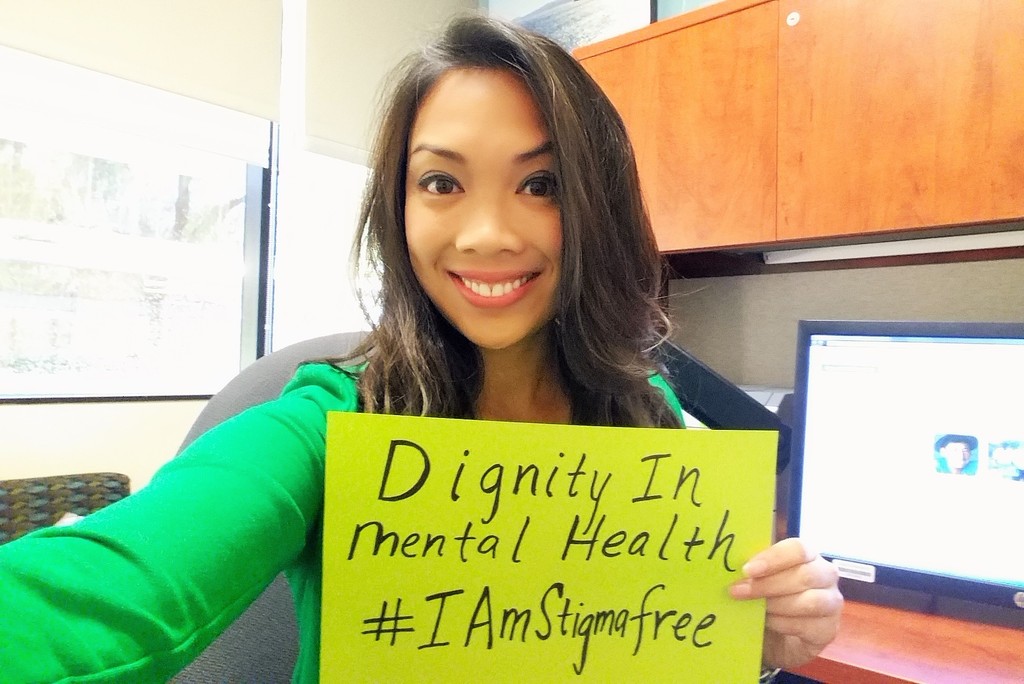
It’s a busy week for raising mental health awareness. Today is World Mental Health Day (October 10th), which is a day observed for discussing issues, garnering support, and mobilizing efforts to improve the treatment and public attitudes towards people living with mental illness worldwide (this year’s theme is “Dignity In Mental Health”). Today is also the final day of Mental Illness Awareness Week (Oct. 4-10), which falls each year during the first week of October to recognize the efforts of the National Alliance on Mental Illness (NAMI) to fight stigma, provide support, and educate the public. This year’s theme is #IAmStigmaFree. As a psychiatrist, I wanted to utilize this opportunity to identify the steps that I regularly take to eliminate stigma in my practice. My process has required a lot of personal work — learning, self-examination, self-reflection, patience; and I acknowledge that I am still a work in progress. However, I want to emphasize that I am working on myself to ensure that my patients receive the best care possible because I know what it’s like to be judged prematurely based on others’ hurtful perceptions.
Our own misconceptions of people living with mental illness are reflected in our interactions. As a physician, I believe it’s important that my fellow colleagues especially be aware of how their actions and words impact patients (ie, anger, impatience, frustration, labeling, etc). Even mental health professionals can perpetuate stigma by not utilizing proper language nor acknowledging how our own stigma impacts the therapeutic relationship (to all of you who’ve ever looked at your patient schedule and uttered phrases such as “greatttt, another psych case,” or “oh geez, it’s that one guy again who can’t stop drinking,” or “she’s so borderline and difficult,” etc — YES, I’m talking to YOU). And again, I admit that I’m not perfect because I’ve mumbled similar phrases in the past myself. Therefore, the following are steps that I take in my own life to ensure that my patients feel understood, rather than stigmatized and judged:
- Be open to changing your perspective towards mental illness
- As I’ve mentioned in previous posts, earlier in my training I was quick to label patients as being “non-compliant,” “agitated,” etc. A stark contrast to my current way of practicing, I didn’t allow proper time to get to know my patients beyond going through a checklist of DSM diagnostic criteria (though one factor may have been naivete as a “green” intern physician, the predominant factor was the influence of the broader society’s stigmatization of the mentally ill population). However, I noticed a drastic shift immediately after I switched residency programs and was introduced to a more humanistic way of practice (the way Psychiatry SHOULD be practiced), where my mentors immediately encouraged me to eliminate words such as “non-compliant,” “agitated” and to get to know patients for who they are as people, NOT just their diagnosis.
- I remember initially resisting my new program’s approach (mostly because I realized that it requires far more effort to be humanistic than it does to robotically rehearse a checklist of information and churn out medication recommendations based on symptoms alone, while minimizing any type of emotional connection with a patient), but welcomed the change in order to grow both personally and professionally.
- Note: For all the providers out there who feel there’s no time allotted in your jam-packed schedule to have empathy while seeing > 20 patients in one day, I feel your pain. The moment I realized the negative impact that being an overworked physician had on my interactions with patients, I decided to quit.
- Separate my own issues from my patients
- When meeting patients for the first time, I admit that sometimes I’m exhausted from work and the last thing I want to do is meet a new patient because, in general, it takes far more effort to meet someone new than it does to see someone whom I’m already familiar with (this sentiment applies to social interactions in day to day life as well). I may start the session off feeling a bit irritable, however, once I start talking to my new patient, my anxiety settles (because I realize their anxiety levels about meeting a new doctor far exceed mine) and realize that my exhaustion and irritability interferes with giving my patient the attention he/she deserves.
- I recall the first time I met my psychotherapist and how high my anxiety levels were during session. How horrified would I have felt if my therapist was quick to judge me for reasons such as wanting to complete the interview within the the shortest time-frame possible rather than taking the time to get to know me? The moment that I identify my own anxiety brought to session when with a patient, I allow myself to relax, which in turn helps my patients feel more at ease as I proceed to ask not only my standard questions, but also thought-provoking questions about their lives in order to better understand them as unique individuals.
- Learn and educate yourself
- When I first had a patient with autism, borderline personality disorder, eating disorder, traumatic encephalopathy, etc, I prioritized researching and gathering as much information as possible in order to better understand and help them. Oftentimes, stigma regarding a specific illness is propagated due to lack of willingness to learn and understand a person’s experience. If I want to fully understand what my patient’s experience with having a specific disorder is like beyond the literature, I ask them! I noticed that my patients appreciate when I ask because inquiring demonstrates that although I may not have firsthand experience with what they’re going through, I truly have an interest in wanting to know what it’s like to live in their shoes.
- Be connected
- The first time I met someone living with mental illness was when my aunt, who has been diagnosed with profound intellectual disability and schizophrenia, came to live with my family when I was in my early teens. Rather than live in fear and avoidance of my aunt (fear and social distancing are contributors to stigma), I made a goal to connect with her on a regular basis (say “hello,” ask questions about her day, shake her hand, comb her hair, etc). Eventually, she warmed up to me and I appreciated her unique qualities such as her love for simple things (dog stuffed animals, a glass of water, sitting outside to get fresh air) and the rotation of her favorite phrases that she’d randomly blurt out (usually pertaining to wanting to visit the Philippines and her sister’s guide dog). Having the connection with my aunt taught me early on of the importance of looking beyond someone’s mental illness.
- Being active on social media also allows me to connect with mental health advocates and people living with mental illness. Outside of clinic, I find that reading their posts and being a part of the social media community provides a deeper perspective of their experiences as clinicians and consumers within the mental health system.
- Share and teach others
- Sharing my experiences and advocating for a humanistic approach to psychiatry is exactly the reason I blog. I recall attending a meeting while working on an inpatient psychiatric hospital during residency and my supervisor yelled at the staff members for laughing at a stigmatizing quip made about one of the patients (staff members clearly felt ashamed and never made such comments during meetings thereafter). I admired my supervisor for standing up for the patients and from that moment on, I never tolerated stigmatizing remarks made in the various places I have worked. Sure, I’ve been the buzzkill during meetings in various clinical environments, but such comments should not be made in the first place. If I can change someone’s perspective and reduce the perpetuation of stigma, then I’ll keep advocating, buzzkilling, sharing, and fighting.






